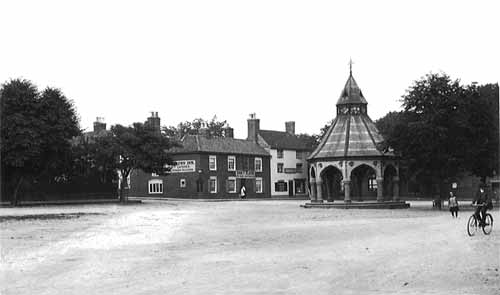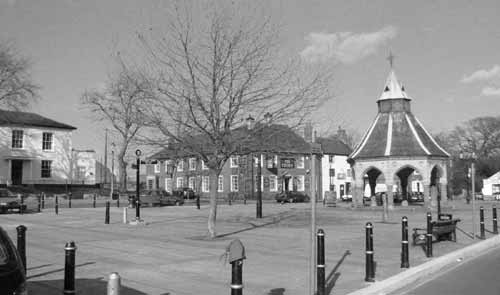![]()
Market Place looking north-east towards Station Street

c.1910

2003
The postcard, from which this early picture is taken, was postmarked September 1917, this coupled with the sign indicating Sam Blood as the landlord of The Crown Inn, suggests that this is a pre-WW1 photograph. Samuel Foster Blood was landlord of the ‘Old’ Crown from around 1908 until the early 1940s. Born in 1868 he first appears in the census of 1891 living in Station Road with his uncle John Foster, a horse trainer, and lists his occupation as ‘comedian’. He retired at the age of 81 from the Town Council on which he served for 52 years. The Market Place is unpaved and a well-worn footpath from Market Street to Station Street is clearly visible. It was first paved in 1960 and in 1966 the ‘old Crown’ was demolished and the new pub built.
The trees, on the left, completely block the view of ‘The Limes’, built in 1854 as the residence of William Clifton, a retired builder. With Vernon House, to its west, it served as part of the Rural District Council offices. Now, in 2004, it houses several private offices. In the 1910 postcard, the trees hide all but the roof of the Blue Bell pub butting onto The Crown in Station Street. There have been two drinking houses on this site, certainly from the early 1800s, pre-dating the building of Station Street (originally called Chesterfield Street) to serve the Great Northern Railway that came to the town in 1851. Prior to 1869, the Crown was called The King’s Arms. When the ‘old Crown’ was demolished in 1966 the ‘Blue Bell’ also disappeared to make room for the larger new building and its car park. The Blue Bell had ceased trading in the early 1900s and, by the 1920s, it was used as the Bingham Institute where the British Legion held its meetings.
With the exception of the Buttercross and a glimpse of a window of the Manor House (c.1700) through its arches, the only original building that can be seen in both pictures is No. 19. This c.1750 house became a shop with the added single-storey extension (hidden by the Buttercross) which, through most of the 1800 and 1900s, housed a number of painter and decorator businesses. The Gray family occupied it from 1891 until the 1970s. No. 19 is currently a pizza parlours and the single-storey extension, an Indian take-away. The Buttercross is largely unaltered but close inspection will reveal slight differences in the lantern that was re-constructed in 1967.
This viewpoint combined with other pictures looking east or west and east from the corner with Market Street give a nearly complete 360 degree panorama of the changes that have occurred around the Buttercross over the past 100 years. In all these c.1900 views, the Market Place looks more spacious without the parked cars and street furniture. The only buildings not included are the Manor House in the north-east corner, No.17 Beauvale House and the adjacent Vernon House on the north side.
